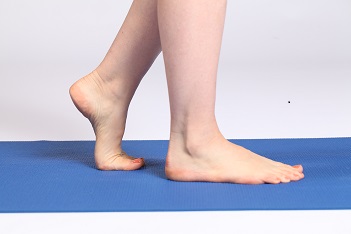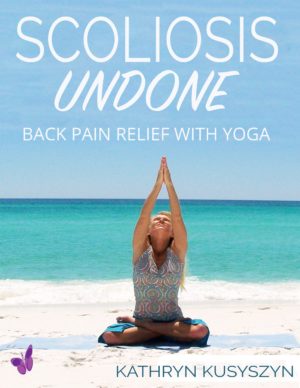
How are your feet?
The Feet
Starting at the feet, did you know that the feet can play a major role in scoliosis? There is a neuromuscular feedback loop from the feet to the pelvis and spine to the brain and vice versa. In scoliosis, this loop can have kinks in it or get cross-wired.
For example, when I started yoga, I would stand in Mountain pose and think that my feet were pointing straight ahead. When I looked down, I could see that my right foot (and leg) was actually pointing to the right. In my mind it felt straight but it wasn’t. Can you relate?
What I learned was that my body awareness was skewed and this created some psychological questioning. Why was my internal felt experience a mismatch with the physical reality? It was very confusing.
I didn’t know that scoliosis makes accurate body awareness challenging. The technical term for the position and movement of body parts in space is proprioception. I only learned that my leg was rolling outward when I began to pay attention to my standing posture. That intrigued me and I’ve kept practicing ever since!
In yoga asanas, you can work with your feet and legs by paying attention to your position in standing postures. Look down at your feet or use a mirror. Notice if the toes of one foot are dripping the mat. Relax them. Feel the soles of your feet connected to the mat. Lift and spread your toes wide and then lower them down. Now notice the feeling of your feet on the mat. Is your weight evenly distributed from right to left? From front to back? Then build your posture from the ground up. ensuring you are firmly grounded before moving. This is sometimes referred to as “root to rise”.

Arches
There are three arches, of the feet; the inside, the outside and one across the top.
Fallen or weak arches are a contributing factor to instability, leg imbalances and foot pain. There are ways to create healthy arches with movement and in yoga practice. I have a couple of YouTube videos on my channel Kathryn Kusyszyn showing some arch-creating exercises. Since they are muscles, I find they need to be done on a regular basis. Healthy arches support a strong foundation in the feet and legs. Strong legs and balanced feet help take the load off the back.
I have found that custom orthotics help support fallen arches which are very common in people with scoliosis. This is a personal choice best made in conjunction with your health provider as there are various factors to consider. I get mine updated every few years or so as I work with my feet and legs and as things change in my body.
Using toe spreaders is also helpful for some people. Personally I found they were really uncomfortable at first and eventually got easier to use. Some people love them and others not so much. This is another matter for personal exploration and assessment.

Fallen arch

Lifted arch
Foot Massage
In my book I give details on how to do an Ayurvedic warm oil foot massage on yourself. This is one of the most grounding and nurturing things you can do for yourself in the evening to calm your mind, get into your body and prepare for deep rest. Sesame, olive, almond or sunflower oils work well, slightly heated. Ahh, just writing about it makes me want to go do one now.
It is a bit messy and you will need to sacrifice a towel and perhaps some socks, however, I find those are a small price to pay. The benefits are numerous and noticeable right away. You increase your awareness of your feet, feel more embodied, learn about the connections between the feet and the rest of the body, relieve tension..it’s also fun to teach someone in your house how to do it and then take turns.
Note that there is a promotion on the e-book version of Scoliosis Undone on now until Feb. 14. Use the code SELFLOVE2022 at checkout. https://yogakat.ca/scoliosis-undone-book/

Foot massage with Spiky balls
These are wonderful for the feet – and many other places too. They come in various sizes. I also use smooth rubber balls (lacrosse or juggling balls are nice and firm) in a sock.
You can play with the amount of pressure you place on the ball as you stand on it and lean into it. There are various pressure points to discover and tension to smooth out. I find it very revealing to assess my feet before working with the spiky ball and after.
This work really helps certain issues in the feet while rolling on a dowel helps other issues, like dropped bones. I have a bone that repeatedly drops in my foot due to the fact that my curve pattern puts a lot of weight on that area.
Foot massage with a seat cushion
This is a seat cushion that I use to stand on for short bouts of dancing. It gives a nice foot massage. For sitting it helps to engage the small stabilizing muscles around the lower back and sacrum as you have to find your balance with it. Dancing on this soft surface is gentle on the joints and gets the lymphatic system working. Lymph needs movement in order to function and since its function is getting wastes to the elimination organs for removal, I am keen to support it working well. One more toy for the toy box!

Foot massage using a Dowel
I use this wooden dowel from the hardware store for foot massage. First I do a bit of rolling and massaging, adjusting the amount of pressure. Then when I lean on it, I can release some tension around the many tiny bones in the foot. Sometimes I hear the snap or crackle of air pockets in cartilage releasing. This provides some relief that has a noticeable positive ripple effect all the way up to my pelvis.

Footwear
This may be a sensitive issue for some. What I have found personally is that shoes with arch support, ankle support and enough space for my foot to have room are the ones that feel the best and work the best in terms of preventing fatigue and pain. I wear Keens, even though I think they are ugly, simply because they are the right shape for my feet and provide the support needed.
Tight shoes, shoes with heels, flip-flops, boots with heels etc. may be fashionable but when I wear them for any period of time I pay the price in my feet, lower back and pelvis. Nothing ruins a fun night out sooner than not feeling like walking anywhere because of pain. High heels throw the weight of the body onto the front of the feet and create instability as well as pain in the pelvis. For someone with an existing imbalance in that area, the imbalance will increase.
When practicing yoga it’s bare feet on the mat. This is to help connect with the earth and increase body awareness.
Indoor shoes and slippers
Here’s a photo of my Birkenstocks that I use as indoor shoes/slippers. I like them because
a) they are wide where my feet are wide
b) they have cork and rubber soles
c) they fit my custom orthotics.
I used to feel it was a chore to keep switching my custom orthotics into my outside shoes to go out and then put them back into my indoor shoes when I came home. I notice my attitude has shifted to one of acceptance. This is simply one small action I take a few times a day to look after my body. The benefits far outweigh the 2 minutes of effort to switch the orthotics over.
This practice of noticing how one’s attitude shifts over time is called svadhyaya, or self-study. It’s an essential part of yoga practice and extremely important for people with scoliosis.

Toe gripping
Do you ever notice your toes gripping the floor or yoga yoga mat? Does it happen more on one foot than the other?
This is common in people with scoliosis. For me it’s the right foot More weight is in my right foot and I tend to lean forward so the toe- gripping is an unconscious strategy that keeps me from tipping forward.
Over time, this action and the related weakness in the muscles and tendons of the toes can create complications like hammer toes, corns, calluses or other issues.
During yoga practice, we can help prevent these issues. If we start to build our poses from the ground up we can get in the habit of creating more balance in the feet. Then by noticing and making any necessary adjustments to our feet and toes position we have a more even and steady base from which to move. Pay particular attention in standing and balancing postures. Let me know what you discover!

Foot related feelings or states of being
Recently a new student asked me this question:
“Is it common for those with scoliosis to feel “ungrounded”…….hard to describe but kind of like brain fog or not being totally connected to the earth? Qigong (especially the Standing Tree Practice), meditation, and stretches seem to help but just wondering if others feel this?”
The answer is YES. This is a big topic and one that I will go into depth around in my new signature program, Scoliosis Release. (Subscribe below to get details in your inbox.)
The short answer is: balance and gait issues, whether related to scoliosis or not, can create a sense of physical instability. Scoliosis itself, being asymmetrical and often causing a head tilt to one side, can contribute to feelings of being lopsided, uneven, floaty, etc.
In Ayurveda, scoliosis is a Vata condition which means it’s related to the relationship between our air and space elements. When these elements are disturbed or out of balance, feelings of spaciness or ungroundedness can result. Kids are often described in this state as “away with the fairies”.
Being in chronic pain can lead one to keep moving and/or escape the physical body mentally with an overactive mind. Sometimes feelings of dissociation or actually leaving the body can occur as well.
The compromised proprioception (awareness of the body parts in space) and interoception (awareness of internal body sensations) that often accompanies scoliosis can contribute to these feelings and sensations.
I like how this person notices that the Standing Tree Practice in Qigong helps her feel more rooted to the earth. In yoga the standing poses achieve this same function, especially if we focus on our feet and build the postures from the ground up. Start with Tadasana, mountain pose, because it’s the foundation of all standing poses and apply this awareness throughout your practice.
For more on this, see my book, Scoliosis Undone. The e-book is on sale now with a 20% off promo code of SELFLOVE2022 until Feb. 14. Scoliosis Undone: Back Pain Relief with Yoga
I trust this information will help you have happier feet. Happy exploring!
